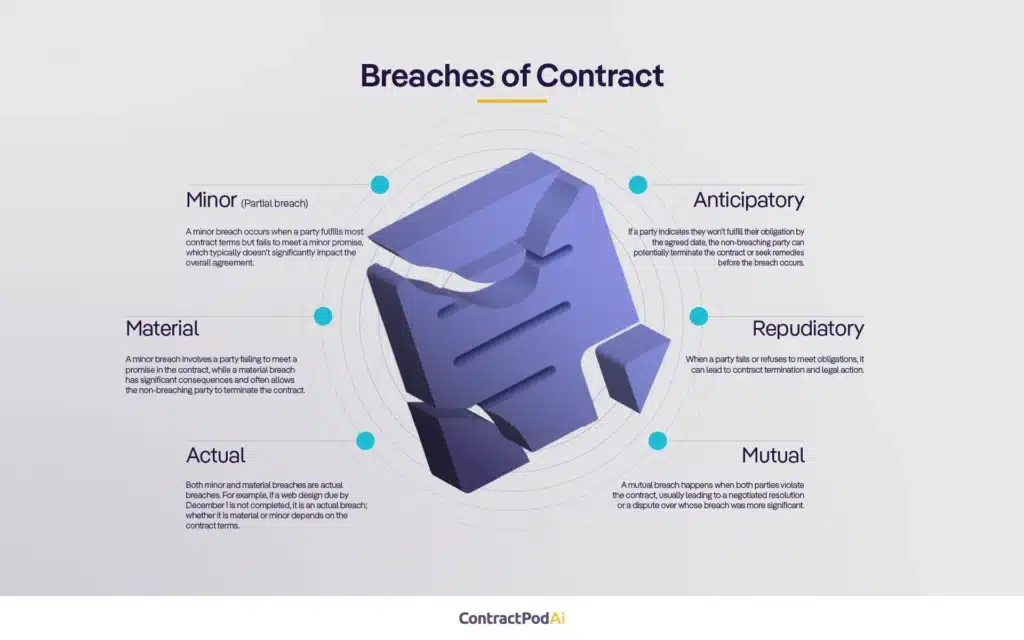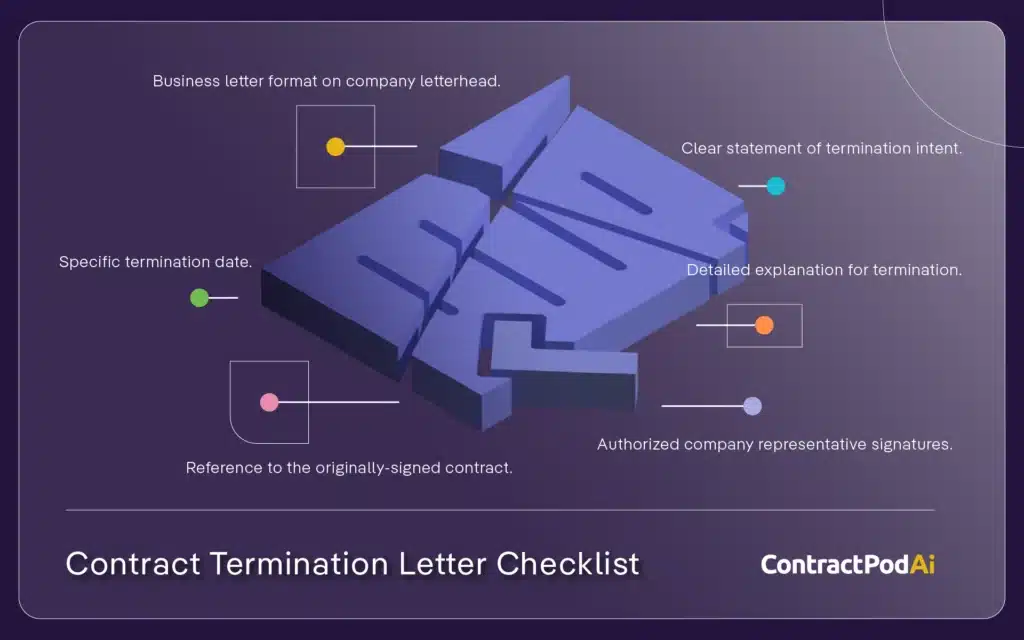Published: August 23, 2022
Updated: August 20, 2024
Understanding Contract Termination
Terminating a contract is the conclusion of the agreement, whether it’s an early termination – before one or more parties fulfill their contract obligations – or the natural end of a relationship between the parties. When a contract is terminated, the obligations within the contract typically also end, except for those that are intended to “survive” (that it stays around and effective) after termination. This means that even though a contract may be over, for better or worse, the parties may still have post-termination obligations and that even though a contract is terminated, the parties might not be precluded parties from pursuing claims for damages under common law or the contract’s termination conditions.
As you can imagine, the reasons for a contract’s termination may vary, and can depend on each party’s situation. But when and how the contract is terminated will determine whether any of the parties are liable for breach of the contract before it was terminated.
Why Does a Contract Get Terminated?
Contracts are terminated for various reasons including:
- Expiration of the terms of the contract: Contract terminates when its specified date or duration expires.
- Example: John’s one-year lease, starting on January 1, 2024, expires on December 31, 2024. At that point, the contract terminates unless both parties agree to renew it.
- Termination for convenience (T for C clause): One party terminates the contract for practical reasons, without any breach by the other party. Both parties are typically satisfied when this outcome occurs.
- Example: Party’s needs change, Party arranges a different party to complete the contract
- Impossibility of performance (Force Majeure): Unforeseen, unpredictable, uncontrollable events make it impossible to fulfill the contract obligations.
- Example: Serious injury, illness, death, weather, war, natural disasters, or legislated law changes that impact the project
Six Types of Contract Breaches
Another reason for contract termination is a breach of the agreement. There are six types of contract breaches and they often need a judge to come sort things out:

1. Minor Breach (Partial Breach):
A party fulfils most of the terms of the contract, but fails to meet a minor promise in the contract. Often the promise that is not fulfilled does not significantly impact the other contract terms so it does not lead to severe consequences.
2. Material Breach:
This is similar to a minor breach in that one party fails to meet a promise in the contract. However, a material breach has a significant consequence and often gives the non-breaching party legal rights to terminate a contract.
3. Actual Breach:
Both “minor breaches” and “material breaches” are subsets of actual breach. For example, if you contract for a web design service due by December 1, and the designer doesn’t complete by that date, it is an actual breach. Whether it is material or minor will depend on other terms in the contract.
4. Anticipatory Breach:
A party indicates that they will not be able to fulfill their obligation, for example, by the agreed-upon date. If this occurs, the non-breaching party can potentially terminate the contract or seek remedies, such as payment, before the breach happens. Typically, this happens when a party finds out the other party is about to commit a repudiatory breach (👇).
5. Repudiatory Breach:
This occurs when a party demonstrates that it is unwilling or unable to fulfill its obligations. This is often viewed as a serious matter and leads to contract termination and legal action.
6. Mutual Breach:
A mutual breach may occur if both parties have breached the contract or are in the process of doing so. Typically, this will end in a negotiated result – but it might end up in a fight over whose breach was worse!
What Are The Conditions for Terminating a Contract?
Contracts can be terminated under various conditions, ensuring fairness and legality in agreements. Key reasons for termination include fraud or mistakes during formation, changes in law rendering the contract illegal, breaches by any party, and mutually agreed-upon terms for ending the contract under specific circumstances. Understanding these conditions helps in effectively managing and dissolving contracts when necessary.
Example Conditions for Contract Termination:
Fraud or a mistake: If the contract was formed under circumstances that include fraud, the contract can be terminated.
Illegality: If the main subject of the contract becomes illegal because of a new law, the contract may become illegal and, therefore, must be legally terminated.
Breach of the contract: All contract parties have a responsibility to perform obligations according to the contract. If a party fails to perform them, blocks the other party from performing the same, or violates the terms of the contract, they will have breached the contract, and the contract can be terminated.
Prior agreements: The contract parties may agree together to allow the termination of the contract under specific circumstances. Those specific conditions must be in place in order to prevent a breach of a contract.
How Does a Party Terminate a Contract?
A contract is a legally binding document that ties parties together and can range from simple to extremely complex. Terminating a contract can be tricky, as there are several legal and ethical aspects to consider, which should be clearly outlined in the contract language and must be carefully reviewed before taking any actions. Parties should specifically look for termination clauses that help define legitimate reasons that would allow a contract to end early.
Contract Termination Notice
Contract termination often starts with a termination notice or letter, with the terms and conditions for delivering this notice being outlined within the agreement. This is a formal communication from one party to the other that expresses the intention to terminate a contract. The notice will state the grounds for termination, including specific contractual clauses that legally justify the action. If the contractual requirements in the agreement are not met, termination notices could lead to legal
disputes or challenges.

Contract Termination Letter Checklist:
- Business letter format on company letterhead
- Clear statement of termination intent
- Reference to the originally-signed contract
- Detailed explanation for termination
- Specific termination date
- Authorized company representative signatures
Dispute Resolution
If a dispute arises during the termination process due to termination validity or compensation, there are a few common dispute resolution mechanisms that help address these issues in a formal manner. These include: negotiation, mediation, arbitration, or litigation.
Negotiations: When parties seek to resolve a dispute amicably, they often try negotiation first. This occurs when parties communicate openly seek to find potential compromises that will avoid protracted legal proceedings.
Mediation: The goal of mediation is for a neutral third party to facilitate discussions between the parties to reach a mutually acceptable resolution. Mediation allows parties to openly share their feelings and explore their grievances in a controlled environment.
Arbitration: Some contracts specify arbitration as the preferred method for resolving disputes. This is a more formal process when an arbitrator or a panel of arbitrators, which are neutral third parties that serve as judges, renders a binding decision after hearing both sides argue their case. Once arbitrators render a decision, it is typically confidential and cannot be appealed.
Litigation: This is usually the least-preferred method of dispute resolution as it can be costly and timely. However, when all other efforts fail, parties turn to litigation through the court system. It will include a plaintiff and defendant – both making their case in front of a judge of jury. The verdict will stay on the public record. Litigation can often end in the pretrial period of a case with a settlement agreement between parties.
What are Contract Termination Remedies?
Contract termination remedies are the different options available for parties to address contract breaches or violations, including:
Compensatory (Monetary) Damages: Financial compensation, that is a reasonable estimate to the actual harm suffered, to cover losses that result from the breach.
Specific Performance: Breaching party must fulfill their contractual obligations.
Liquidated Damages: Breaching party must provide a specified, predetermined amount of damages to the other party. The amount must be reasonable and proportional to the potential harm.
Rescission (Restitution): The contract is canceled and the parties are restored to their pre-contractual positions.
How Does Contract Termination Fit within the CLM Process?
A standard agreement should go through the entire contract lifecycle: initiation, authoring, editing and review, approval, tracking and auditing, reporting — and, finally, renewal or termination. But today’s organizations typically hold 20,000 to 40,000 contracts at a time. And when companies manage contracts manually, they can have a difficult time keeping track of them all. They can miss out on renewal and termination opportunities, and lose a significant amount of revenue. However, this issue can be solved with a contract lifecycle management (CLM) system with automated workflows and notifications.
To learn more about modern contracting, download our Contract Management Fundamentals Guide. It is a free guide that includes a handy contract management checklist for you and your legal team. And to find out how ContractPodAi can help you adopt and implement a CLM system of your own, contact us today to book a demo.








